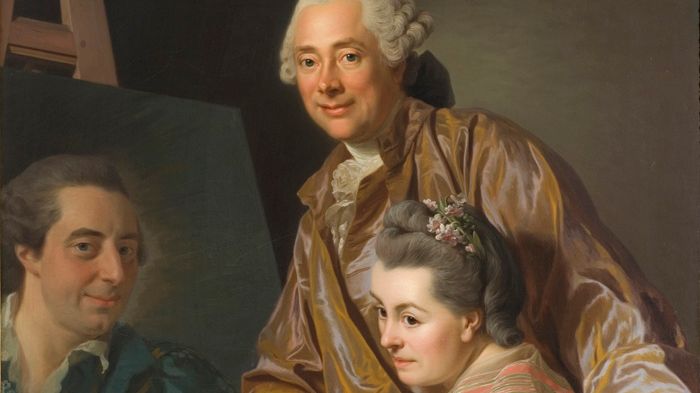
Press release -
New acquisition: Family portrait by Alexander Roslin
Nationalmuseum has acquired a
portrait of Alexander Roslin and his wife Marie Suzanne Giroust painted by the
artist himself. The museum is delighted to have had the opportunity to acquire
this unique and rarely shown work. The acquisition has been made possible by an
extraordinary contribution from the Friends of Nationalmuseum.
The newly acquired Roslin family portrait was painted by Alexander Roslin in 1767. In the summer of 1754, Roslin was asked to take over various purchasing duties in Paris on behalf of Carl Gustaf Tessin. When Henrik Wilhelm Peill, Tessin’s protegé, arrived in Paris on a European study tour in the mid-1760s, Roslin and his wife welcomed Peill with open arms. As a token of the resulting close friendship, Roslin painted the portrait of himself and his wife, Marie Suzanne Giroust, at the easel working on a pastel of Peill. The painting was produced toward the end of Peill’s visit. The portrait within the portrait has never been found, but several copies exist of an earlier version produced by Marie Suzanne Giroust the previous year.
The gold box housing the miniature portrait that Roslin is pointing at is part of the rebus-like nature of the painting and may have been a lavish farewell gift from Peill. The inscription on the frame, Loin et près (“Far away and [yet] close”), makes it clear that the portrait was indeed a token of friendship. Peill most likely acquired the painting that same year or in the years that immediately followed. Shortly after his return to Sweden, he married Anna Johanna Grill the younger, daughter of the late Claes Grill the elder, former director of the Swedish East India Company. The evidence suggests that the younger woman portrayed in miniature on the gold box in the painting is Miss Grill, while the older woman is probably her mother, Anna Johanna the elder.
In this light, it is easy to understand why Roslin felt called upon in September 1775 to paint the Grill Family Portrait, which is now in the Gothenburg Museum of Art. The painting of the widowed Anna Johanna Grill the elder with her children Adolf Ulric and Anna Johanna the younger readily tied in with the group portrait of the Roslins that has now been acquired by Nationalmuseum. However, the family portrait did not include Mrs Grill’s son-in-law, Peill, but rather her late husband. In keeping with convention, he is depicted in another degree of reality, in the form of a pastel portrait by Gustaf Lundberg in the background. The inscription complements that of the pendant and adds multiple levels of meaning: Loin et près/Unis à jamais (“Far away and [yet] close/United for ever”).
For a long time, the Roslin family portrait belonged to the descendants of the heir to Henrik Wilhelm Peill and Anna Johanna Grill the younger, her nephew Per Adolf Tamm, a baron and factory owner. This unique work by Alexander Roslin from the Österby collection eventually came into the possession of Baroness Stina Nordenfalk, née Rålamb. Nationalmuseum has now purchased the work from her heirs at a price of SEK 19,5 million. The acquisition has been made possible by means from the museum’s own funds plus a generous contribution from the Friends of Nationalmuseum and a private donation. The painting has been exhibited to the general public on a few previous occasions such as two temporary exhibitions at Nationalmuseum: Alexander Roslin in 2007 and Pride and Prejudice in 2012. Nationalmuseum is therefore delighted to confirm that an important piece of Swedish cultural heritage has been saved for future exhibition as part of the museum’s permanent collection.
Further information
Magnus Olausson, Director
of Collections and the Swedish National Portrait Gallery: magnus.olausson@nationalmuseum.se,
+46 8 5195 4371
Hanna Tottmar, Press
Officer: hanna.tottmar@nationalmuseum.se,
+46 767 234632
Caption
Alexander Roslin, Self-portrait
with his wife Marie Suzanne Giroust painting a portrait of Henrik Wilhelm Peill, 1767.
Categories
Nationalmuseum is Sweden’s premier museum of art and design. The collections comprise older paintings, sculpture, drawings and graphic art, and applied art and design up to the present day. The museum building is currently under renovation and scheduled to open again in 2017. In the meantime, the museum will continue its activities through collaborations, touring exhibitions and a temporary venue at the Royal Swedish Academy of Fine Arts, Fredsgatan 12, Stockholm. Nationalmuseum collaborates with Svenska Dagbladet, Fältman & Malmén and Grand Hôtel Stockholm. For more information visit www.nationalmuseum.se.

